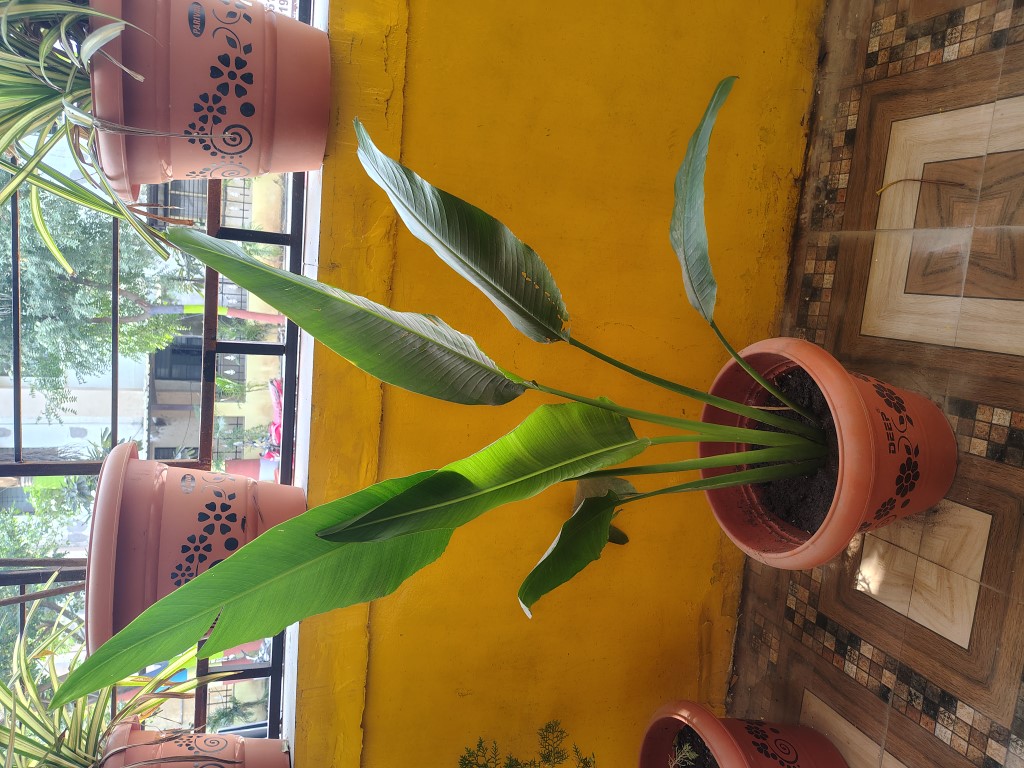Green Campus/Tree Details

केळीचे झाड ( Banana Palm Tree )
केळीचे झाड (Musa spp.) हे एक उष्णकटिबंधीय, सदाहरित झाड आहे. याला सामान्यतः "केळीचे झाड" किंवा "केळीचा पाम" म्हणून ओळखले जाते. हे झाड मुख्यतः त्याच्या स्वादिष्ट फळांसाठी ओळखले जाते, जे जगभरातील लोकांच्या आहाराचा महत्त्वाचा भाग आहेत. केळीच्या झाडाला "पाम" (Palm) म्हणून देखील संबोधले जाते, पण त्याचा बोटांची आकृती आणि झाडाच्या आकारामुळे असं समजलं जातं.
1. झाडाची ओळख आणि वैशिष्ट्ये (Identification and Features)
केळीचे झाड 4 ते 7 मीटर उंच वाढू शकते आणि त्याचे मोठे, गुळगुळीत आणि लांब पान असतात. पानांचा आकार सामान्यतः 1.5 मीटर पर्यंत असतो आणि त्यांचा रंग गडद हिरव्या किंवा पिवळसर हिरव्या रंगात असतो. केळीच्या झाडाची मुख्य ओळख म्हणजे त्याची पृष्ठभागावर गुळगुळीत आणि लवचिक मण्यांची फुलं. प्रत्येक केळीच्या झाडाच्या मुळातून एक मोठा टोकळा वाढतो जो झाडाच्या वरील भागाशी जोडलेला असतो, आणि त्याच्यावर केळीच्या समूहांची वाढ होते.
2. लागवडीसाठी टिप्स (Planting Tips)
केळीचे झाड उष्ण आणि आद्र वातावरणात चांगले वाढते. त्याला दररोज कमीत कमी 6 तास सूर्यमालक प्रकाशाची आवश्यकता असते. यासाठी उत्तम निचरण करणारी माती आणि उबदार हवेची आवश्यकता आहे. केळीचे झाड पाणी प्रेमी असले तरी ओलसर माती टाळावी लागते. योग्य पाणी आणि मातीच्या स्थितीत हे झाड चांगल्या प्रकारे वाढते आणि केळीचे उत्पादन करते.
3. केळीच्या झाडाचे फळ (Banana Fruit)
केळीच्या झाडाची फुलं साधारणतः फुलांच्या गुच्छात असतात. त्यात विविध रंग आणि प्रकार उपलब्ध आहेत, परंतु सामान्यतः केळीचे फळ पिवळ्या रंगाचे, गोड आणि ताजेतवाने असतात. केळीचा वापर फळ म्हणून तसेच विविध खाद्यपदार्थांमध्ये केला जातो. याच्या वापराचे स्वरूप बरेच आहे—केळी ताजे खाणे, केळीचा शेक बनवणे, केळीचे हलवे, केळीची वडी, आणि इतर प्रकारचे पदार्थ.
4. औषधी गुणधर्म (Medicinal Properties)
केळीच्या झाडाच्या पानांमध्ये औषधी गुणधर्म असू शकतात. केळीची पानं आणि बियांतील पदार्थ पारंपरिक औषधांत वापरले जातात. याचे फळ पचनाच्या समस्या, हृदयाचे आरोग्य आणि कॅल्शियमच्या प्रमाणाचे नियंत्रण करण्यासाठी उपयुक्त आहे. केळीला उच्च कॅलोरीयुक्त आणि ऊर्जा देणारे फळ मानले जाते. तसेच, केळी खाल्ल्याने मूड सुधारतो आणि मानसिक आराम मिळवतो.
5. सजावट आणि पर्यावरणीय उपयोग (Decorative and Environmental Uses)
केळीचे झाड सजावटीसाठी देखील वापरले जाते. याचे मोठे पाणीदार पान बागांमध्ये छायाचित्रांची जादू घालतात आणि त्याला आकर्षक बनवतात. याचा उपयोग घराच्या अंगणात, बागांमध्ये, आणि व्यावसायिक स्थळांवर देखील केला जातो. केळीचे झाड पर्यावरणासाठी देखील उपयुक्त आहे कारण ते हवामानाच्या स्थितीशी जुळवून चालते आणि वाऱ्यापासून संरक्षित ठरते.
6. देखभाल आणि संगोपन (Care and Maintenance)
केळीचे झाड देखभाल सुलभ आहे, परंतु त्याला भरपूर सूर्यप्रकाश, पाणी आणि योग्य मातीच्या स्थितीची आवश्यकता आहे. वाऱ्यामुळे केळीच्या झाडाच्या पानांना जास्त त्रास होऊ शकतो, म्हणून त्याला छायेत ठेवणे किंवा फाटक ठेवणे महत्त्वाचे असते. प्राचीन झाडाचे देखभाल करताना नियमितपणे पाणी देणे आणि योग्य फवारणी करणे आवश्यक आहे.
The Banana Palm Tree (Musa spp.) is a tropical, evergreen tree famous for producing bananas, one of the most widely consumed fruits worldwide. Often referred to as the Banana Tree or Banana Palm, it is not technically a palm but rather a large herbaceous plant that can resemble a tree. The tree is native to Southeast Asia but has been cultivated in tropical regions across the globe for its edible fruit.
1. Identification and Features
The Banana Palm Tree typically grows to a height of 4 to 7 meters. It has large, smooth, long leaves that are around 1.5 meters in length. The leaves are typically a dark green or yellowish-green in color. The main feature of this tree is its bunches of bananas, which grow from a large stalk at the top of the tree. The banana fruit grows in clusters, with the fruit ripening over time, changing from green to yellow as they mature.
2. Planting Tips
Banana trees thrive in warm, tropical environments and require at least 6 hours of sunlight each day. They need well-drained soil that is rich in organic matter, along with a humid climate to grow well. Banana trees are water-loving but should not be overwatered as they are susceptible to root rot in waterlogged conditions. With proper care, these trees grow quickly and yield large bunches of bananas.
3. Banana Fruit
The banana is a fruit that grows in clusters or bunches, and it typically ripens from green to yellow. Bananas are sweet, soft, and packed with nutrients. They are used in a variety of ways, such as eating raw, blending into smoothies, or incorporating them into recipes like banana bread, cakes, and pies. They are also an important food source in many tropical and subtropical regions.
4. Medicinal Properties
The banana tree is known for its medicinal uses, particularly its fruit. Bananas are rich in potassium and dietary fiber, which aid in digestion, support heart health, and help regulate blood pressure. The fruit is also believed to have mood-boosting effects and is a natural energy source. In traditional medicine, banana leaves and other parts of the plant are used to treat wounds and soothe various ailments.
5. Decorative and Environmental Uses
The Banana Palm Tree is not only useful for its fruit but also for its ornamental value. Its large, green leaves provide a tropical aesthetic, making it a popular choice for gardens, parks, and even indoor spaces. The tree’s structure creates a lush, vibrant atmosphere in landscaping designs.
Moreover, banana trees play a role in maintaining environmental balance by stabilizing the soil and promoting air quality in the areas where they are planted.
6. Care and Maintenance
Caring for a Banana Palm Tree is relatively simple. It requires regular watering and sunlight but should not be exposed to strong winds that may damage its large leaves. The tree needs periodic feeding with organic fertilizers to ensure healthy growth and a good banana harvest. Protection from extreme weather conditions and pests is important for the tree’s survival.
The Banana Palm Tree is an essential part of tropical agriculture and ornamental gardening. With its edible fruit and aesthetic appeal, it serves multiple purposes, both in homes and on farms. Whether for food, decoration, or environmental benefits, it is a versatile and valuable tree to grow.
